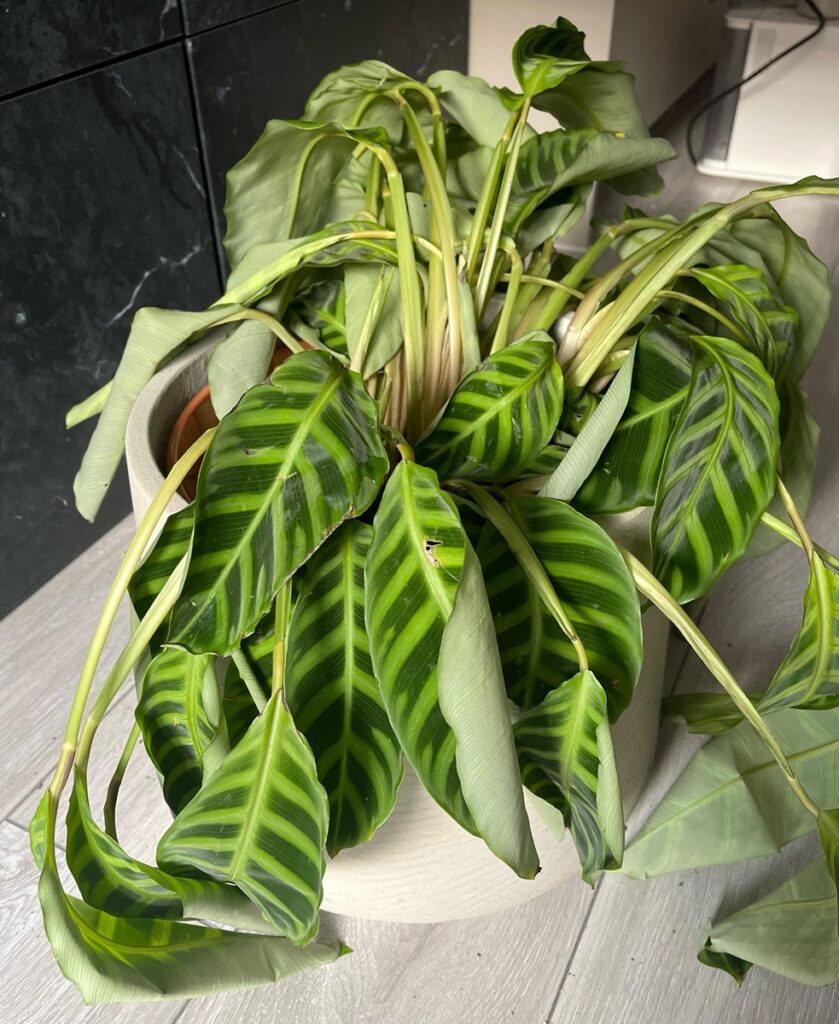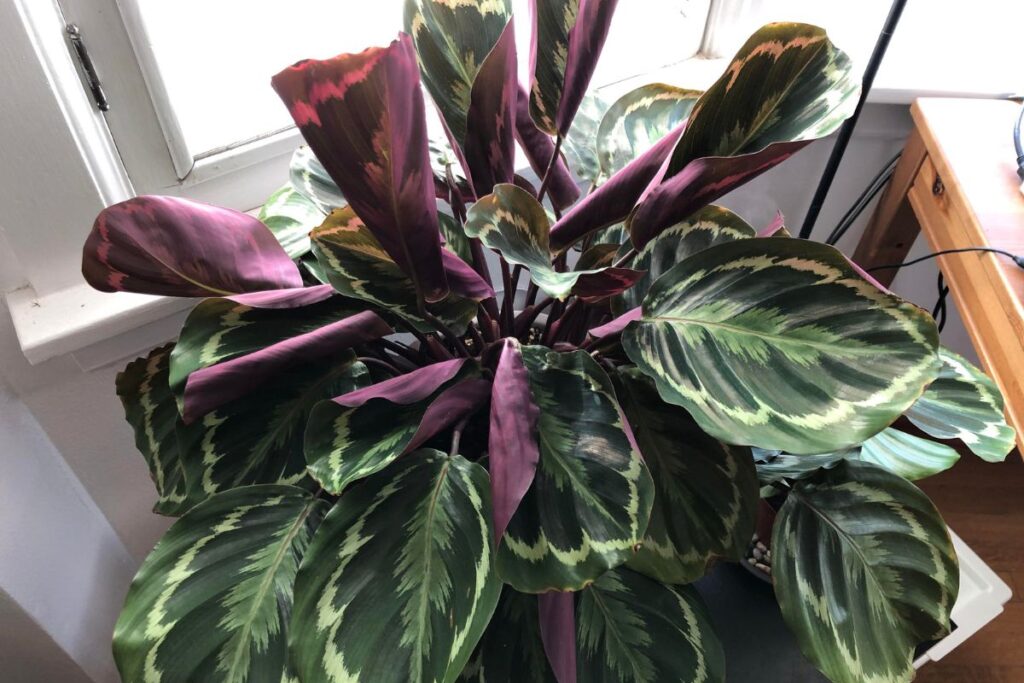Calathea owners often panic when their plant’s signature broad leaves begin curling inward, resembling tightly closed umbrellas. This dramatic leaf movement signals underlying stress, though distinguishing between normal daily rhythms and genuine distress requires careful observation. While these prayer plants naturally fold their foliage at night, persistent curling during daylight hours indicates environmental imbalances, watering mistakes, or hidden threats lurking in the soil that demand immediate investigation.

Contents
- 1 Understanding Natural Leaf Movement vs. Stress Indicators
- 2 Watering Issues: Too Much, Too Little, or Poor Quality
- 3 Environmental Stressors: Temperature and Humidity Imbalances
- 4 Light Exposure Problems and Optimal Placement
- 5 Fertilization Mistakes That Damage Your Plant
- 6 Pest Infestations and Disease Identification
- 7 Fungal Problems in High Humidity Conditions
- 8 Recognizing Signs of a Healthy Calathea
Understanding Natural Leaf Movement vs. Stress Indicators
When Calathea leaves curl inward, distinguishing between natural behavior and stress signals becomes essential for proper plant care. Healthy Calatheas fold their leaves upward each evening, revealing colorful undersides as part of their circadian rhythm. This movement, called nyctinasty, indicates proper plant function and should occur consistently with light changes.
Stress signs differ markedly from these natural behaviors. Leaves that remain tightly curled throughout the day, curl downward instead of upward, or show brown edges signal underlying problems. Additionally, if the regular evening folding stops entirely, the plant likely faces watering, humidity, or light issues requiring immediate attention.
Watering Issues: Too Much, Too Little, or Poor Quality

While natural leaf movement follows predictable patterns, improper watering creates persistent curling that signals genuine distress. Underwatered Calatheas curl leaves inward to conserve moisture, requiring consistent soil dampness. Overwatering causes yellowing, wilting, and potential root rot from waterlogged conditions. Proper watering techniques include bottom watering through drainage holes, avoiding leaf splashing that encourages disease.
Water quality greatly impacts leaf health, as tap water’s chlorine and minerals accumulate in soil over time. These salts cause browning tips and persistent curling. Switch to distilled or rainwater for best results. Water temperature should be lukewarm, never cold, which can shock roots and trigger protective leaf curling.
Environmental Stressors: Temperature and Humidity Imbalances
Beyond water-related problems, temperature and humidity fluctuations create their own set of curling challenges for Calathea owners. These tropical plants demand specific environmental conditions, thriving in temperatures between 60°F and 85°F with humidity levels hovering around 60%.
Effective temperature regulation means avoiding cold drafts from windows, air conditioners, or heating vents. When temperatures drop below their comfort zone, leaves curl inward as protection against the stress.
Humidity control becomes equally essential, especially in drier climates. Use humidifiers or pebble trays filled with water to maintain ideal moisture levels, preventing defensive leaf curling from occurring naturally.

Light Exposure Problems and Optimal Placement
How much light proves too much for these finicky tropical beauties? Calatheas prefer bright, indirect sunlight, but direct rays trigger defensive leaf curling. When harsh sunlight hits leaves, they curl inward to shield themselves from damage, often developing brown spots and faded patterns.
Effective lighting techniques involve positioning plants near north-facing windows or filtering harsh light with sheer curtains. Smart placement strategies include keeping Calatheas three feet from south-facing windows, using grow lights positioned twelve inches away, or placing them under larger plants for natural shade. Move scorched plants to dimmer locations immediately for recovery.
Fertilization Mistakes That Damage Your Plant
Overfeeding these tropical plants creates more problems than undernourishment ever could. Excessive fertilization damages roots, causing leaves to curl and become brittle. Most fertilizer types contain concentrated salts that build up in soil, fundamentally dehydrating the plant from within.
Apply balanced fertilizer only every two months during growing season. More frequent feeding overwhelms Calatheas, which naturally grow slowly. Nutrient deficiencies rarely occur with proper watering and quality potting mix.
If overfertilization occurs, flush soil thoroughly until drainage water runs clear. Skip fertilizing for several months afterward, allowing roots to recover completely.
Pest Infestations and Disease Identification
Unfortunately, several pests and diseases frequently target Calathea plants, causing distinctive leaf curling that differs from environmental stress. Red spider mites attack leaf undersides, creating webbing and mottled appearance. Check regularly for these tiny invaders, especially in dry conditions.
Fungal diseases like powdery mildew produce visible spots alongside curling, while botrytis creates grey mold in high humidity. Southern blight kills plants quickly through root rot and stem lesions.
Effective pest management includes insecticidal soaps and improved air circulation. Disease prevention requires proper watering techniques, avoiding leaf splash, and using fungicides when necessary to maintain plant health.
Fungal Problems in High Humidity Conditions
Ironically, the very humidity levels that help Calathea plants thrive can become their downfall when fungal spores take hold. Botrytis creates grey mold patches, while powdery mildew forms white, dusty coatings on leaves. Southern blight attacks roots aggressively, and rust develops orange-colored blisters in moist conditions.
Effective fungal treatment requires targeted fungicides applied according to package directions. However, prevention works better than cure. Humidity control becomes essential—maintain levels between 40-60% rather than constantly high moisture. Improve air circulation around plants, avoid water on leaves, and remove affected foliage immediately to prevent spread.
Recognizing Signs of a Healthy Calathea
Understanding a healthy Calathea becomes easier when gardeners know what behaviors signal plant wellness rather than distress. Regular folding movement indicates ideal Calathea health, with leaves consistently responding to light changes throughout day-night cycles. Healthy plants exhibit vibrant leaf coloration, displaying crisp patterns and rich hues without browning or fading.
Movement should align with natural rhythms, where leaves fold upward at night, revealing colorful undersides, then open during daylight hours. Leaves remaining curled all day suggest problems requiring attention.
Robust Calatheas maintain consistent folding behaviors, strong structural integrity, and brilliant coloration that makes their intricate patterns pop with visual appeal.
